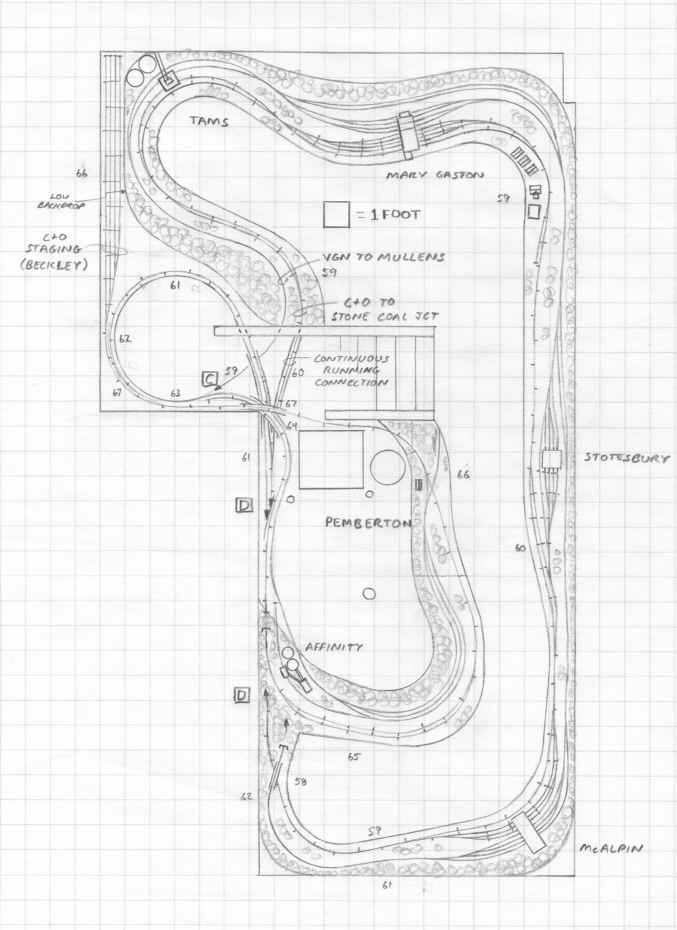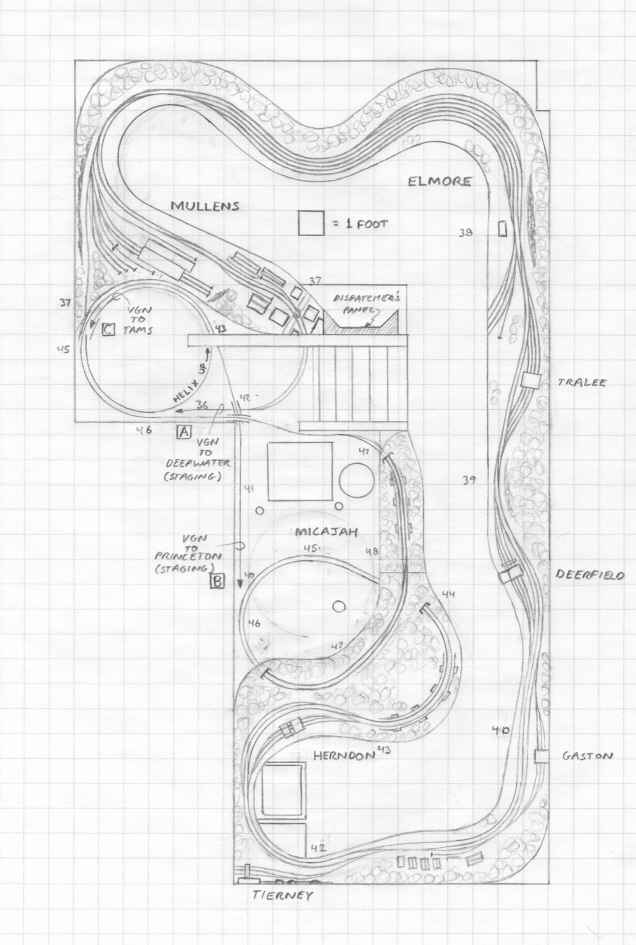- Size: 19′ x 33′
- Scale: HO
- Minimum Radius: 30″
- Minimum Aisle Width: 30″
- Designed by Dan Bourque
 Elmore was the center of Virginian Railway operations in the coal fields. Mullens, just north (railroad west) of Elmore, was home to a major engine facility and the western terminus of electrification on the Virginian. Traffic through Elmore was predominantly coal, but there was meager non-coal traffic in the form of traffic to and from the NYC and C&O at Deepwater, WV. Because of the tipples included, this trackplan best fits the timeframe between 1940 and 1970. Prior to 1962, the mainline was electrified and the Virginian (N&W after 1959) used heavy electrics to lift heavy trains over the mountains all the way to the division point of Roanoke. After 1962, N&W power, both 4 and 6 axle, was used. During both the Virginian and N&W eras, the VGN’s FM Trainmasters were the workhorses for mine runs.
Elmore was the center of Virginian Railway operations in the coal fields. Mullens, just north (railroad west) of Elmore, was home to a major engine facility and the western terminus of electrification on the Virginian. Traffic through Elmore was predominantly coal, but there was meager non-coal traffic in the form of traffic to and from the NYC and C&O at Deepwater, WV. Because of the tipples included, this trackplan best fits the timeframe between 1940 and 1970. Prior to 1962, the mainline was electrified and the Virginian (N&W after 1959) used heavy electrics to lift heavy trains over the mountains all the way to the division point of Roanoke. After 1962, N&W power, both 4 and 6 axle, was used. During both the Virginian and N&W eras, the VGN’s FM Trainmasters were the workhorses for mine runs.
The Layout
This track plan replaces an earlier version that was “retired” from this website because it had too many faults. The main focus of this railroad is the double-track main from Elmore to Micajah. This was a helper district for all loaded trains moving east from Elmore to Clark’s Gap (a few more miles east of Micajah). Obviously, in this track plan, helpers would have to cut off at Micajah, but there would still be a nice, long helper run. Another feature of this layout is the BIG tipples. You’d have to have a ton of hoppers to begin to fill all of the loading tracks on the main deck and upper deck.
The upper deck represents the Virginian’s Winding Gulf Branch which departed the mainline at Mullens and wound up a valley which it shared with the C&O. Many of the large tipples on the line could load over both the Virginian and C&O. On this layout, the C&O is fully operational. The C&O entered the valley from the north via a switchback, and tracks ended at Stone Coal Jct. where it interchanged cars with the Virginian. Unfortunately, Stone Coal Jct. would not fit into this track plan.
The lower deck of this railroad (Mullens to Micajah) could also form the basis for some alternate upper decks instead of the Winding Gulf Branch. One option would be to model the mainline north of Mullens toward the connection with the C&O and NYC at Deepwater, WV. Another option would be to continue modeling the line east of Micajah towards Princeton, WV.
The staging level is generous and turns the mainline into a continuous running loop which is great for recycling trains in an ops session. In this instance, the height of the washer and dryer in the room limit the spacing between the staging and lower levels, but it’s still workable. Due to the large number of locomotives needed as well as helper operations, a large DCC system with walk-around throttles would be a necessity.
Upper Level (Winding Gulf Branch)
Lower Level (Mullens to Micajah)
Staging Level
Operations
Operations would keep several operators busy for a few hours. Elmore would need one or two full-time operators just to build mine runs and coal drags and to shuttle power from Mullens to the yard for new trains. Mainline traffic would consist primarily of coal, but at least a few trains daily would run through from Mullens to Micajah with more diverse merchandise traffic to and from the NYC interchange at Deepwater (staging). Two to four mine runs would be needed to serve all the mines on the layout. One or two would work the mines east of Elmore, while the others would work the Winding Gulf Branch and the C&O interchange at Pemberton. Of course, helpers would be needed as often as coal drags departed from Elmore heading east (at least 5-6 times per operating session). Also, because the staging yard is double ended and provides a continuous running loop, trains from Deepwater to Princeton could be recycled to add more traffic to an operating session. Don’t forget, at least one operator will be busy operating 2-3 C&O trains on the Winding Gulf branch every session, and finally, a dispatcher would be needed to keep things straight!
At times, there were a few mine runs called out of Pemberton instead of Elmore during both the Virginian and N&W eras–this would be a great feature to model. Pemberton was also an interchange point with the C&O where the C&O would give the VGN empties for the Affinity tipple, and the VGN would give the C&O empties to be loaded at Crab Orchard, just north of Pemberton.
Things I Like About this Plan:
- Helpers!
- Lots and lots of operation
- Lots of big loaders
- C&O is fully operational
- Mullens provides lots of room for showcasing locomotives
- Decent amount of non-coal traffic
- Ability for continuous running
- Easily accessible staging for the VGN
Things I Don’t Like About this Plan:
- Spaghetti bowl of hidden trackage
- Mainline from Elmore to Micajah is considerably compressed
- C&O staging is tough to access
- Some places where track goes through backdrop are not well disguised
Related Products:







